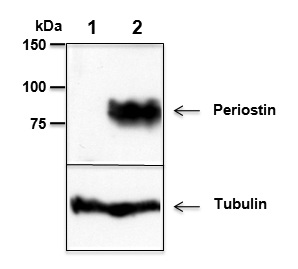
Immunofluorescence of frozen sections of human melanoma SKMEL-28 cells grown in NOD/SCID mice, double-stained using anti-Periostin, mAb (blocking) (OC-20) (preservative free) (AG-20B-6000YPF) (Red) and anti-mCD31 (green), and counterstained with DAPI.
anti-Periostin, mAb (blocking) (OC-20) (preservative free)
AG-20B-6000YPF
ApplicationsImmunoCytoChemistry, Neutralisation/Blocking
Product group Antibodies
ReactivityHuman, Mouse
Overview
- SupplierAdipoGen Life Sciences
- Product Nameanti-Periostin, mAb (blocking) (OC-20) (preservative free)
- Delivery Days Customer10
- ApplicationsImmunoCytoChemistry, Neutralisation/Blocking
- CertificationResearch Use Only
- ClonalityMonoclonal
- Clone IDOC-20
- Concentration1 mg/ml
- Estimated Purity>95%
- HostMouse
- IsotypeIgM
- Scientific DescriptionMonoclonal Antibody. Isotype: Mouse IgMkappa.Immunogen: Recombinant fragments of human periostin.. Application: FUNC (Blocking), ICC. Liquid. In PBS. Recombinant fragments of human periostin. Periostin is a 90-kDa matricellular protein that consists of a typical signal sequence, followed by a cysteine-rich region, an EMI domain (protein-protein interactions), four tandem fasciclin-like domains that are responsible for integrin binding, and a C-terminal region. Periostin was originally isolated as an osteoblast-specific factor that functions as a cell adhesion molecule for pre-osteoblasts and in osteoblast recruitment, attachment and spreading. Periostin is also involved in many fundamental biological processes such as cell proliferation, cell invasion and angiogenesis. Periostin expression is increased by both transforming growth factor beta1 (TGF-beta1) and bone morphogenetic protein 2 (BMP-2). Changes in periostin expression are commonly detected in various cancers and pre-cancerous conditions, and periostin may be involved in regulating cancer cell activities that contribute to tumorigenesis, cancer progression and metastasis. Periostin has shown to be involved in many aspects of allergic inflammation, such as eosinophil recruitment, airway remodeling, development of a Th2 phenotype and increased expression of inflammatory mediators. It is evaluated as a biomarker for bronchial asthma and airway inflammation. - Periostin is a 90-kDa matricellular protein that consists of a typical signal sequence, followed by a cysteine-rich region, an EMI domain (protein-protein interactions), four tandem fasciclin-like domains that are responsible for integrin binding, and a C-terminal region. Periostin was originally isolated as an osteoblast-specific factor that functions as a cell adhesion molecule for pre-osteoblasts and in osteoblast recruitment, attachment and spreading. Periostin is also involved in many fundamental biological processes such as cell proliferation, cell invasion and angiogenesis. Periostin expression is increased by both transforming growth factor beta1 (TGF-beta1) and bone morphogenetic protein 2 (BMP-2). Changes in periostin expression are commonly detected in various cancers and pre-cancerous conditions, and periostin may be involved in regulating cancer cell activities that contribute to tumorigenesis, cancer progression and metastasis. Periostin has shown to be involved in many aspects of allergic inflammation, such as eosinophil recruitment, airway remodeling, development of a Th2 phenotype and increased expression of inflammatory mediators. It is evaluated as a biomarker for bronchial asthma and airway inflammation.
- ReactivityHuman, Mouse
- Storage Instruction-20°C,2°C to 8°C
- UNSPSC12352203


![anti-Periostin [OSF-2], mAb (Stiny-1) (preservative free)](https://adipogen.com/pub/media/catalog/product/a/g/ag-20b-0033-anti-periostin_mab_stiny-1_-wb_4.png)